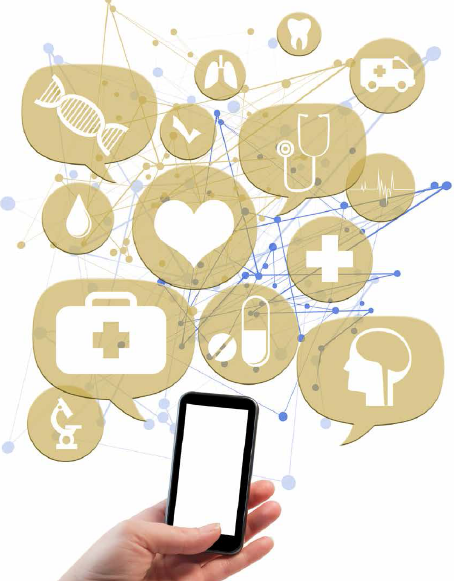 Wearables are emerging as a solution for creating a more nimble and efficient clinical trial process, from recruiting patients to collecting real-world patient data. While the movement is still in its infancy and there are several challenges and hurdles to overcome before wearables become commonplace in the industry, there are demonstrable benefits of using wearables in the clinical trial setting to increase the volume and speed of data collection.
Wearables are emerging as a solution for creating a more nimble and efficient clinical trial process, from recruiting patients to collecting real-world patient data. While the movement is still in its infancy and there are several challenges and hurdles to overcome before wearables become commonplace in the industry, there are demonstrable benefits of using wearables in the clinical trial setting to increase the volume and speed of data collection.
The challenges, interestingly, are in direct relation to the benefits: an increased volume of data, a decreased quality in data, and how to accurately interpret the data, as well as privacy and accuracy risks.
“The challenges that need to be overcome for wearables to become a source of outcomes data in clinical trials are directly attributable to the opportunities that wearables provide," says Thaddeus Wolfram, senior manager, life sciences advisory practice, EY.
Wearables are starting to make inroads in the clinical space. For example, Apple’s ResearchKit has already proven the benefit of using smartphone apps for patient recruitment in just its few short months on the market. Stanford University was able to recruit 11,000 participants for a heart disease study in just 24 hours using Apple’s ResearchKit, a feat that would normally take 50 medical centers an entire year to accomplish using traditional approaches. The University of Pennsylvania had been struggling for three years to recruit enough patients for a study on the impact of exercise on breast cancer survivors. Over three years, researchers mailed 60,000 letters and recruited only 351 patients. In March of this year, the team released a ResearchKit app called Share the Journey, which examines the same subject with less stringent enrollment criteria. In just one month, 2,000 patients had enrolled in the program.
Medidata has partnered with Garmin’s Vivofit activity tracker to provide patient engagement, data quality, and operational efficiencies in  clinical trials. Garmin’s Vivofit will capture clinical trial patient data and integrate it with other traditional clinical data, including labs, vital signs, medical history, and adverse events. The data are pulled from the Garmin activity tracker in 15-minute increments and then analyzed to evaluate the connection with traditional clinical measures and to determine whether Garmin data can provide better insights into a patient’s health status or response to therapy.
clinical trials. Garmin’s Vivofit will capture clinical trial patient data and integrate it with other traditional clinical data, including labs, vital signs, medical history, and adverse events. The data are pulled from the Garmin activity tracker in 15-minute increments and then analyzed to evaluate the connection with traditional clinical measures and to determine whether Garmin data can provide better insights into a patient’s health status or response to therapy.
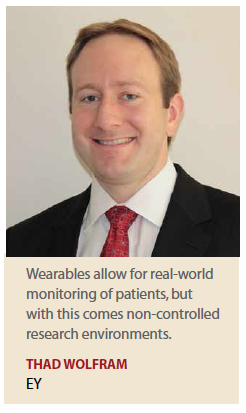 “As mHealth technologies become more sophisticated and intuitive, there is tremendous opportunity to use them in clinical trials," says Kara Dennis, managing director of mHealth, Medidata. “These technologies have the potential to help gather more and better data on patients’ response to therapy and progression of disease. Still, as with any transformative technology, mHealth tools present the industry with new operational, technical, and regulatory challenges."
“As mHealth technologies become more sophisticated and intuitive, there is tremendous opportunity to use them in clinical trials," says Kara Dennis, managing director of mHealth, Medidata. “These technologies have the potential to help gather more and better data on patients’ response to therapy and progression of disease. Still, as with any transformative technology, mHealth tools present the industry with new operational, technical, and regulatory challenges."
According to Susan Dallabrida, Ph.D., VP of clinical science and consulting, PHT Corp., wearables pose a great opportunity to more seamlessly collect large quantities of longitudinal physiological measurement data in clinical research.
“However, this poses a number of challenges for researchers, with one of the foremost being how to turn that data into quantifiable safety and efficacy measures and endpoints," she says. “Transforming activity data into meaningful outcomes that translate into significant treatment benefits to patients is work that still needs to be done."
For example, data collected from activity devices may not always be valuable to the trial, and standards are needed to provide guidance.
“Wearables hold great promise for enhancing clinical trial outcomes; however, standards must be 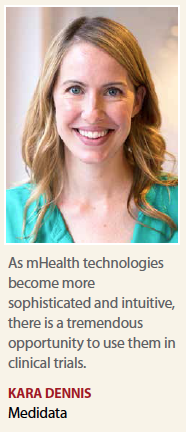 created within the context of the attempted outcomes assessment," says Nick Richards, VP, product management, Parexel International. “This will be particularly challenging for activity-type monitors that stream data, given the absence of structured procedures for their use compared with protocols established for other apparatuses, such as spirometers."
created within the context of the attempted outcomes assessment," says Nick Richards, VP, product management, Parexel International. “This will be particularly challenging for activity-type monitors that stream data, given the absence of structured procedures for their use compared with protocols established for other apparatuses, such as spirometers."
Interpreting data from wearable devices has been a problem since the first wearable was used in 1960 when continuous ECG data were first collected. The challenges then are the same as today: how to evaluate and identify the data pertinent to the clinical trial outcome.
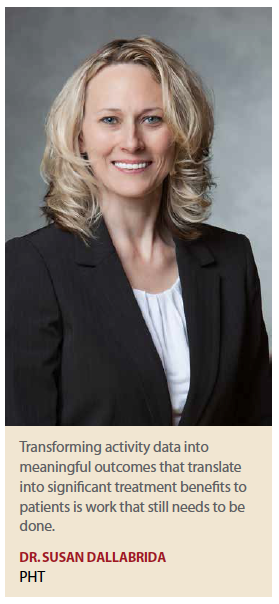 “Wearables allow for real-world monitoring of patients, but with this comes non-controlled research environments and the need to address patient device use and adherence variability, as well as the incorporation of study data that are not directly observed by the researchers," Mr. Wolfram says. “Wearables offer a new source of data but industry standards are needed to align measures for compliance across the computer systems that collect and analyze wearable data as clinical data."
“Wearables allow for real-world monitoring of patients, but with this comes non-controlled research environments and the need to address patient device use and adherence variability, as well as the incorporation of study data that are not directly observed by the researchers," Mr. Wolfram says. “Wearables offer a new source of data but industry standards are needed to align measures for compliance across the computer systems that collect and analyze wearable data as clinical data."
Compared with data collected in a traditional controlled clinical environment, real-world wearable scenarios create higher volume, lower quality data, and semantic clarity is critical to speed up adoption of this type of data for use in outcomes research.
“For example, the non-controlled research environment poses a less straightforward challenge when it comes to the realities of real-world variability, which also means there is more room for innovative and alternative methods of addressing the concern," Mr. Wolfram says.
“Planning for variability will require pre-determining the context within which data will be 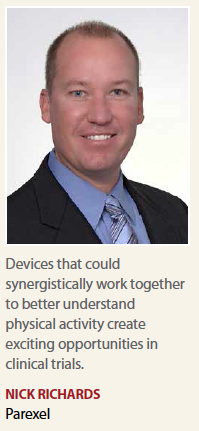 evaluated to determine what variability is acceptable, and what will be required in trial design to drive to the right degrees of statistical power and significance."
evaluated to determine what variability is acceptable, and what will be required in trial design to drive to the right degrees of statistical power and significance."
During a collaboration with GlaxoSmithKline, Medidata gathered 18 million data points per patient per day. The sheer volume of data can leave many sponsors wondering how to best use it all, Ms. Dennis says. Using an appropriate repository, researchers can visualize the data and demonstrate the types of insights available.
“We see tremendous opportunity to apply data science techniques to identify trends and outliers in clinical data, and use those insights to design better subsequent trials," she says.
The volume of new data, along with new devices used in an uncontrolled environment, also sets the stage for threats to participant privacy. Therefore a secure environment is needed for wearable data collection, storage, and transfer, Mr. Wolfram says. Addressing both data standards and privacy concerns will require collaboration across the industry and with regulators. Currently accepted standards and privacy controls for health data provide a good starting point. These can be built upon, with input from health authorities, to establish new standards that should be designed to enable efficient incorporation of wearables into clinical trials while meeting the requirements and expectations of participants and regulators.
“This approach will help create semantic clarity around data that come from nontraditional clinical settings where wearables are likely to 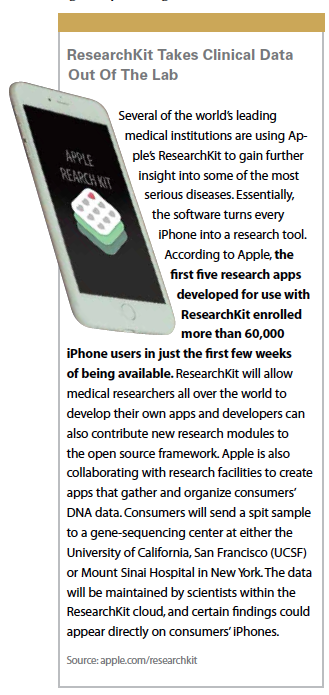 deliver the most benefit," Mr. Wolfram says.
deliver the most benefit," Mr. Wolfram says.
The specific wearable will have to be considered when it comes to mitigating variability of device use, and for how the technology itself can be used to validate how and from whom the wearable data were collected.
“In all cases, it will be imperative to maintain transparent communication with regulators on the trial design plan, to build regulator agreement on the course to be taken, and to have downstream acceptance of the trial outcomes data," Mr. Wolfram says.
From a technical perspective, sponsors are seeking to identify a wearable that is both easy to use and can collect high-quality data.
“This hasn’t been an easy exercise, but we’re getting close," Ms. Dennis says. “For example, one of the key reasons we integrated Garmin’s Vivofit with the Medidata platform was the activity tracker’s year-long battery life, which has the potential to increase compliance among study participants while generating high-quality data."
External variables can also impact measurements and influence behavioral patterns that play into outcomes. One such variable might include the daily activity of someone who works in an office all day during the week but is active during the weekend, compared with someone who is retired and may demonstrate more erratic activity patterns on any given day. With so many variables creating “noise" in the data, efforts must be taken to filter data in a consistent manner, Mr. Richards says.
“The idea that devices — potentially a combination of multiple devices worn on different parts of the body — could synergistically work together to better understand physical activity creates new and exciting opportunities in the context of a clinical trial," he says. “Yet, to make this effective, the industry must establish common guidelines to identify all possible external variables at play and to assess their potential impact on the data collected. In any field of science, unknown variables have the potential to skew results."
Investigative sites also need to be prepared to train patients on how to use and wear devices. Although many devices are getting much easier to use, they are not yet foolproof in a context that requires strict compliance, so additional training needs to be in place.
“It is imperative that in the tightly controlled world of clinical trials that subjects are able to keep their devices charged, connect them to the Internet, and download any necessary mobile apps," Ms. Dennis says.
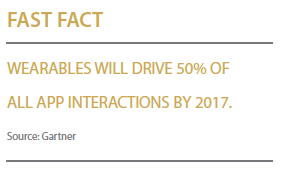 Wearables also raise regulatory challenges as sponsors work to better understand requirements for submitting mHealth data to regulatory agencies, including the FDA. For example, sponsors may have questions on regulatory-compliant approaches to safety monitoring of mHealth data. One approach is to make data available in near real time for pharmacovigilance, and support this oversight with algorithms to understand trends in patient safety, Ms. Dennis adds.
Wearables also raise regulatory challenges as sponsors work to better understand requirements for submitting mHealth data to regulatory agencies, including the FDA. For example, sponsors may have questions on regulatory-compliant approaches to safety monitoring of mHealth data. One approach is to make data available in near real time for pharmacovigilance, and support this oversight with algorithms to understand trends in patient safety, Ms. Dennis adds.
While forward thinkers note that using wearable technology in clinical trials can only improve a system of data collection that has been in place for decades, they also acknowledge that the industry will first have to tackle the issues of data standards, privacy, and accuracy to reach a point of full adoption.
“This will take collaboration with academics, industry, regulators, technologists, and patients to turn all these newly accessible data streams into meaningful, actionable and useful knowledge," she says. “But it has to be done." (PV)

















